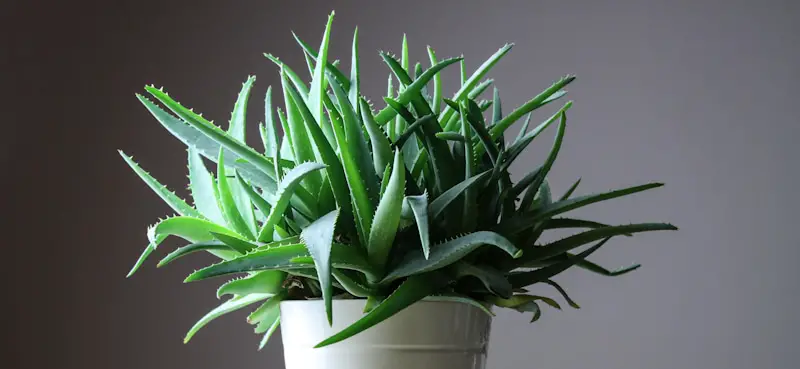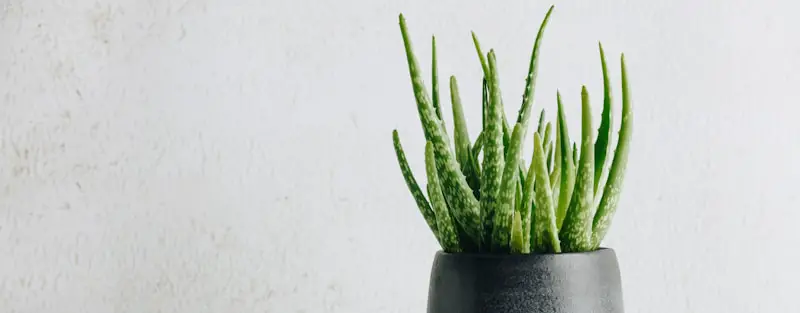Aloe Vera is a popular household plant with great medicinal benefits like aiding the treatment of wounds and bites, as well as skin improvement. While this plant is quite easy to grow and maintain, a common problem many gardeners face is the Aloe plant’s green leaves turning brown. Several factors cause this; however, to correct this problem, the most important thing is to identify the potential cause. So, let us find out.
Some of the reasons why your Aloe Vera plant turns brown are improper light exposure, underwatering, overwatering, pests attack, cold air or drafts, excessive fertilizer, plant damage, sunburn, diseases, high salt content of the soil, sudden changes in growing conditions, leggy growth, and root rot.
Although Aloe Vera plants do not require much care and attention because they are succulents, you need to maintain proper care for the plant to grow properly and not turn brown.
Why Is My Aloe Vera Plant Turning Brown?
Aloe Vera, like other plants, often turns brown when faced with watering problems, which could be due to a lack of adequate or excessive water in the root. Asides from this, other things like pest attacks, excess fertilizers, excessive sunlight, and cold temperature could also make an Aloe Vera turn brown. Below, we will better explain the common reasons why your Aloe plant is turning brown.
Overwatering
Water is essential for Aloe Vera’s survival; however, too much watering of this plant will make its root rot and develop brown leaves. Overwatering is more likely if your plant begins to appear soggy before its leaves eventually turn yellow or brown. Generally, Aloe Vera is meant to be watered once every 15 to 20 days or when the soil is about 75% dry.
Doing anything outside this will be overwatering. Solving overwatering problems often requires repotting your Aloe Vera into suitable soil in a good drainage pot. However, carefully examine all the roots and eliminate any mushy or rotten roots with a clean cutter. Failure to remove the rotten root could make the whole plant die.
Underwatering
Just as too much water is not good for Aloe Vera, the lack of adequate water is also not good for them. Underwatering is usually a likely cause if your Aloe Vera leaves begin to turn brown at the tip. If this is not corrected quickly, the brown color will eventually spread, making your plant look unhealthy or malnourished.
The best solution to this problem is to give your plant what it lacks – water. Ensure you water the plant well and also drain out excess water. Additionally, if you notice the temperature is a bit hot, and your Aloe Vera plant soil dries out faster, you might increase the watering rate to once every fortnight.
Excessive Fertilizer
Although fertilizers help speed up the general growth of plants, when used inaccurately, there are adverse effects, including wilting, stunted growth, and dried or burned leaves. For Aloe Vera plants, fertilizers should be used every 6 to 12 months since they do not require it to survive.
When fertilizers become too much in an Aloe Vera plant, the soil tends to accumulate a lot of unwanted salt content, polluting the soil and affecting the plant’s roots, thereby causing brown leaves. To correct fertilizer problems, you must flush out the excess unwanted chemicals from the soil with water.
Pests Attack
There is an assumption that Aloe Vera plants are hardy and are not subject to pest attacks – this is false. Pest attack is also a reason why an Aloe Vera plant turns brown. Pests like aphids, mites, fungus gnats, whitefly, and caterpillars can feed on the leaves of this plant and could lead to severe consequences if not promptly resolved.
Common signs of pest attacks include the physical presence of the culprits, a weird yellow, brown, black spot, or unusual growth on your plant leaves. To deal with pest attacks and save your plant, you must cut away the affected leaves with a clean cutter. Once that is done, depending on the pest, you can get rid of them by spraying your plant with a high-pressure water hose.
Excessive Sunlight
If you recently exposed your Aloe Vera plant to direct sunlight and its leaves begin to get brown, the plant is likely suffering from sun exposure. Although these plants are rugged, the best form of light for survival is indirect sunlight under a temperature of about 55 to 850 Fahrenheit.
So, if you suspect your plant is suffering sunburn due to excessive sunlight, reposition the plant indoors close to an east-facing window where it can receive adequate sunlight. However, if you consider transitioning your plant from outdoor to indoor, ensure you do it gradually. A sudden transition could make your plant develop shock and burn.
Cold Temperature
Did your Aloe plant suddenly develop brown leaves when the weather became very cold? If yes, the sudden change could be due to the cold environment. If your plant is exposed to any temperature below 550 Fahrenheit, your plant might suffer shock from the cold and begin to develop brown leaves.
To avoid this, during cold weather, the best thing is to ensure your plant is not positioned close to spots like windows, doors, or around fans or air conditioners where it could easily feel cold. If you reside in a growing zone where the chances of Aloe Vera plants turning brown outdoors are high, you should add straw or other insulation around the plant’s base.
Why Is My Aloe Plant Turning Brown At The Base?
The most common occurrence is for the Aloe Plant to turn brown, and we have gone over the cause, but when you notice that the plant is turning brown at the base, you need to identify the cause. The major reasons why an Aloe Vera plant turns brown at the base are underwatering and inadequate sunlight.
Many Aloe Vera planters confirm that it is normal for Aloe Vera plants to turn brown at the base; this is to give way to new leaf growth. This is a part of the plant’s life cycle, and you have nothing to worry about. However, if the plant turns brown at the base and there is no new growth, you should take swift action.
Aloe Vera plants require about 4 to 6 hours of direct sunlight for normal growth and development. So, if the plant is under shade, away from sunlight, it becomes pale and weakens. When this happens, the Aloe Vera redirects all the available resources to grow the inner leaves towards the direction of sunlight, so the leaves at the base turn brown.
Why Is My Aloe Plant Turning Brown At The Tips?
Another unusual occurrence is when your Aloe Vera plant turns brown at the tips. It is safe for you to cut off the brown tips, but you must also identify the cause to prevent it. The major reasons for this are dehydration or fungal infections. If the cause is dehydration, you can cut the tip off; if not, you would have to remove them.
Pruning is good for the Aloe Vera plant as it aids the development of healthy leaves. So, if parts of the plant are turning brown, it is safe to cut them off because they are less likely to improve. Damaged leaves cannot harness light and hold the water needed for photosynthesis.
Final Thoughts
Aloe Vera is a plant everyone should have at home due to its various health benefits. However, the plant is not beneficial if brown, so you must care for it properly to prevent it from turning brown. If you see brown spots on your Aloe Vera plants, you know how to identify and resolve the cause.
Victoria is the owner and main author of hobby plants. She loves spending her free time in her garden planting and taking care of her plants. Victoria hopes you enjoy the content here!


![Why Is My Bamboo Plant Turning Yellow? [Find Out Here] Why Is My Bamboo Plant Turning Yellow? [Find Out Here]](https://www.hobbyplants.com/wp-content/uploads/2022/07/why-is-my-bamboo-turning-yellow-300x158.jpg)
![Why Are My Orchid Leaves Turning Yellow? [Find Out Here] Why Are My Orchid Leaves Turning Yellow? [Find Out Here]](https://www.hobbyplants.com/wp-content/uploads/2022/07/orchid-leaves-turning-yellow-300x158.jpg)
![Why Are My Bird of Paradise Leaves Curling? [FIND OUT HERE] Why Are My Bird of Paradise Leaves Curling? [FIND OUT HERE]](https://www.hobbyplants.com/wp-content/uploads/2022/07/bird-of-paradise-leaves-curling-300x158.jpg)
![Why Are My Peace Lily Leaves Turning Brown? [EXPLAINED] Why Are My Peace Lily Leaves Turning Brown? [EXPLAINED]](https://www.hobbyplants.com/wp-content/uploads/2022/07/peace-lily-leaves-turning-brown-1-300x158.jpg)
![How Often Do You Water A Snake Plant? [FIND OUT HERE] How Often Do You Water A Snake Plant? [FIND OUT HERE]](https://www.hobbyplants.com/wp-content/uploads/2022/07/how-often-do-you-water-a-snake-plant-1-300x158.jpg)
![How To Propagate Bird Of Paradise? [Find Out Here] How To Propagate Bird Of Paradise? [Find Out Here]](https://www.hobbyplants.com/wp-content/uploads/2022/08/how-to-propagate-bird-of-paradise-300x158.jpg)
![How Big Do Different Types Of Azaleas Get? [Find Out Here] How Big Do Different Types Of Azaleas Get? [Find Out Here]](https://www.hobbyplants.com/wp-content/uploads/2022/09/how-big-do-azaleas-get-300x158.jpg)
![Why Does My Majesty Palm Have Brown Tips? [EXPLAINED] Why Does My Majesty Palm Have Brown Tips? [EXPLAINED]](https://www.hobbyplants.com/wp-content/uploads/2022/08/majesty-palm-brown-tips-300x158.jpg)

![What Causes Brown Tips on A Ponytail Palm? [EXPLAINED] What Causes Brown Tips on A Ponytail Palm? [EXPLAINED]](https://www.hobbyplants.com/wp-content/uploads/2022/08/brown-tips-on-ponytail-palm-300x158.jpg)

